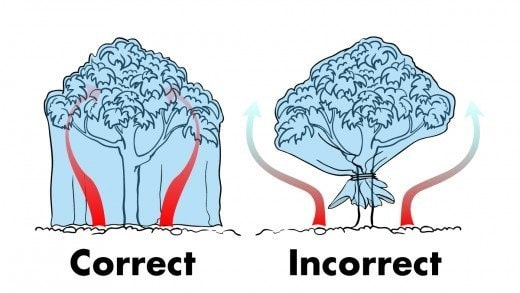|
Covering Your Plants: If you’re going to cover up your plants before a frost or freeze, do so before dusk. If you wait until darkness falls, most of the stored heat in your garden will have dissipated. No matter what type of cover you use, make sure that it extends down to the soil on each side. Do not leave any openings for warmth to escape. If you can, it's also advisable to use stakes to keep material, especially plastic, from touching the foliage. Do not affix or gather your cover to the trunk, however, as this will prevent the heat radiating up out of the soil from reaching the plant. In the morning, after the frost has thawed, remove the covers. Failing to do so could cause the plant to break dormancy and start actively growing again, which would make it even more susceptible to frost damage in the future. What can I cover my plants with to protect them from frost? Here are just some of the items you can use to cover your tender plants:
Woody trees and shrubs (both fruit and landscape) and many herbaceous perennials (including strawberries) can tolerate very low temperatures if they are allowed to harden off and go dormant in the fall. Hardening off is triggered by the shorter days of late summer and fall, which cause the plant to stop growing. At this time, overwintering buds are matured. Different plant tissues have different degrees of hardiness. For example, flower buds are more sensitive to cold than leaf buds. A frost may damage the flower buds of a bulb or fruit tree without harming subsequent foliar growth. Most flowering shrubs will not be damaged by temperatures as low as 32 to 30F. However, if it goes much lower than that, open flowers may be damaged. If foliage is damaged it will regrow. Critical temperatures and cold injury evaluations for small fruit crops: Strawberries Plants, mid-winter: 0°F to 10°F Open flowers: 28°F Grapes New growth: 30°F Woody vine: French hybrids: -5°F to -10°F American: -8°F to -18°F Blackberries Dormant thorny plant: -10°F |
AuthorsCategories
All
Archives
July 2020
|

 RSS Feed
RSS Feed